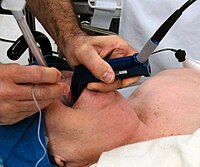
Photo from wikipedia
Pediatric Critical Care Medicine www.pccmjournal.org 1101 Traditional airway management for infants and small children is performed with uncuffed endotracheal tubes (1). There is concern for clinicians regarding airway complications due… Click to show full abstract
Pediatric Critical Care Medicine www.pccmjournal.org 1101 Traditional airway management for infants and small children is performed with uncuffed endotracheal tubes (1). There is concern for clinicians regarding airway complications due to mucosal damage by inflated cuffs or increased breathing effort with a smaller inner diameter of endotracheal tubes when selecting a cuffed tube (2). A novel pediatric endotracheal tube named the Microcuff pediatric endotracheal tube (MPET), with a high-volume, low-pressure, ultrathin polyurethane cuff of shorter cuff length, was developed in the 21st century. Use of the MPET is associated with better clinical outcomes and lower complication rates represented by the occurrence of stridor or clinically relevant airway stenosis necessitating postextubation racemic epinephrine (3). Furthermore, delivery of meticulous ventilator management under reliable ventilator variables, such as tidal volume, plateau airway pressure, and capnography, is accomplished by using appropriate tracheal sealing with a tube cuff. Difficulties in placing the tips of tracheal tubes in the correct position, at the mid-trachea, without the cuff touching the vocal cord or cricoid ring, is a challenging part of pediatric cuffed tracheal tube management. Surprisingly, no reliable methods for correct tube placement have been established to date. Multiple methods of placement are used in clinical practice as follows: 1) intentional endobronchial intubation followed by withdrawal of the tube, 2) adjustment of tube markings at the vocal cords, and 3) use of a mathematical formula with age or height. These different methods can result in tracheal tube malposition. A recent observational study showed that 18% of the pediatric population, with a peak of 35% in infants, showed tracheal tube malposition (4). Another study showed that adherence of age-based guidelines to determine the depth of the tube was as low as 17%, and this adherence was associated with a high incidence of tracheal tube malposition (73%) (5). Therefore, safer and more reliable methods need to be determined for correct tube placement. This is especially the case in infants in whom cuffed endotracheal tubes are still infrequently used (6), and the prevalence of using these tubes is expected to increase. The MPET provides a depth marker just above the cuff and assists in placing the tube at an optimal position while avoiding vocal cord damage by the cuff (7). However, the appropriateness of depth marker-guided placement, specifically in relatively longer use in the PICU, has not yet been confirmed. As reported in the current issue of Pediatric Critical Care Medicine, Matsuoka et al (8) conducted a single-center, retrospective, observational study to identify the incidence and risk factors of inappropriately deep tip positions of MPETs during the PICU stay. A total of 683 patients were intubated, and 225 patients used cuffed endotracheal tubes, and 169 of the 225 patients used the MPET. With adjustment of the intubation depth mark at the level of the vocal cords, 42 patients were considered to have inappropriately deep tip positioning. Of these, 13 (7.3%) had bronchial intubation, as confirmed by chest radiograph during their PICU stay. In multivariate analysis, smaller children, a history of abdominal disease or previous abdominal surgery, and an oversized endotracheal tubes were associated with an inappropriately deep tip position, which was unsurprising. The authors discussed that the distances from the intubation depth mark to the tube tip, as measured by themselves, was differed from those reported previously (9), with a 3–5 mm longer distance. This could have led to a more deeply positioned tip. The position of the depth mark on the MPET was originally determined by radiological and anatomical data so that the cuff did not compress the mucosa within the cricoid. However, the manufacturer had moved the markings away from the tip in 2008 aiming at increasing the cuff-free subglottic zone with the expectation of keeping a safe position above the carina (“personal communication”). The new styled tube was introduced in the Japanese clinical setting in 2014. In this issue of Pediatric Critical Care Medicine, the study by Matsuoka et al (8) suggests that the newly changed depths need to be validated in worldwide clinical settings. Multicenter registries for assessing whether the results of this single-center, Asian study can be extrapolated to other settings with a variety of races are required. Matsuoka et al (8) could not explain why so many patients (24%) had oversized endotracheal tubes, which undoubtedly increases the rate of an inappropriate tip position. Knowing how this inappropriate depth changed if all patients had received the correct tube size would be interesting. No data are available for the actual length of tube insertions at the lips. Provision of the actual depth and its comparison with the traditional ageor height-based formula would also provide useful information for determining better methods of correct tube placement. Finally, provision of data regarding significant respiratory outcomes when identifying the bronchial position would be interesting. This is because a lack of the Murphy eye *See also p. e510.
Journal Title: Pediatric Critical Care Medicine
Year Published: 2019
Link to full text (if available)
Share on Social Media: Sign Up to like & get
recommendations!